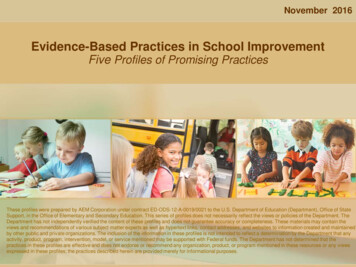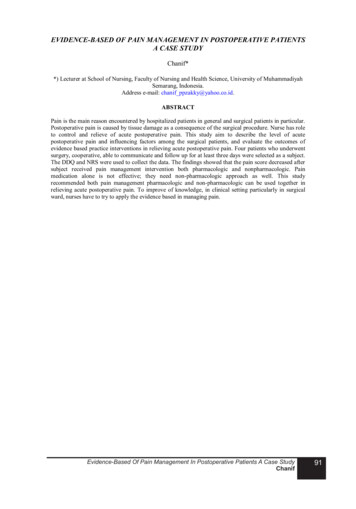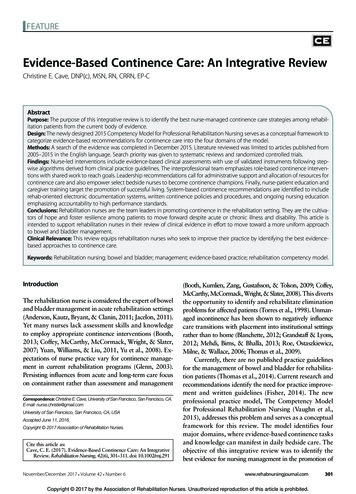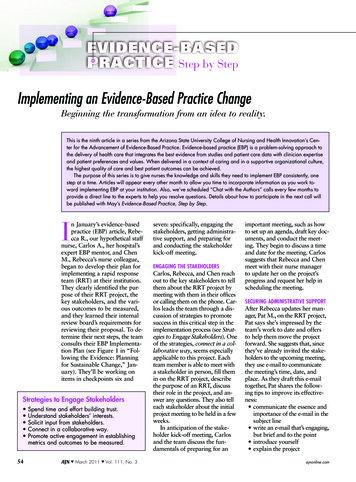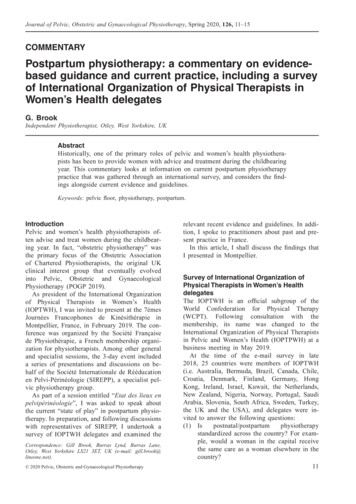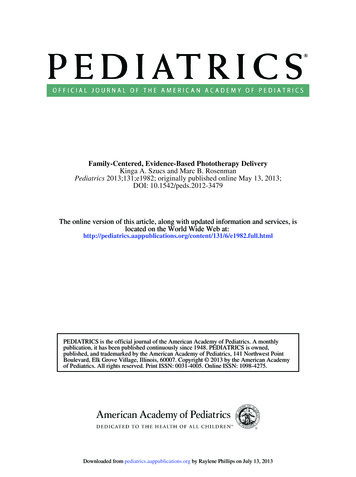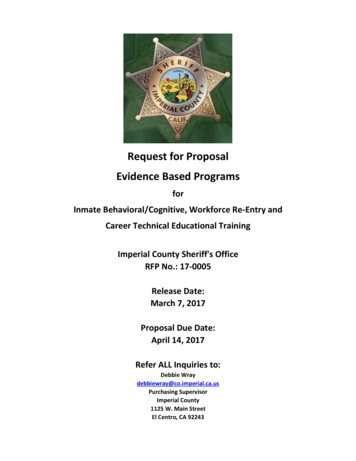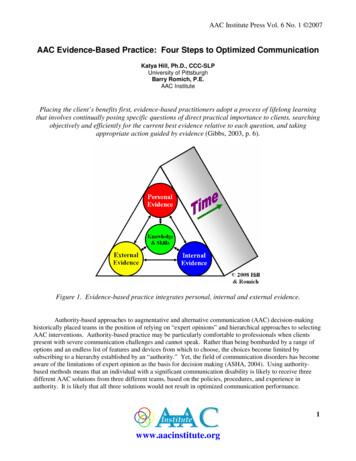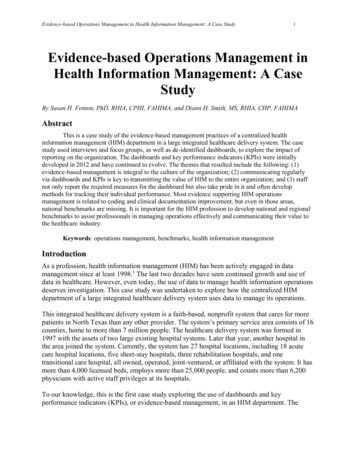
Transcription
EVIDENCED-BASED BEST PRACTICES AROUNDDATA CENTER MANAGEMENTLESSONS LEARNED FROM THE PUBLIC AND PRIVATE SECTORSGeneral Services AdministrationOffice of Governmentwide PolicyOffice of Information, Integrity and Access (ME)August 11, 2016Evidence-Based Best Practices Around Data Center ManagementPage 1
ContentsBEST PRACTICES: AT A GLANCE. 3INTRODUCTION . 4Purpose . 4Why These Best Practices? How Were They Identified? . 5Using This Document . 5DCOI METRICS . 7Energy Metering . 7Power Usage Effectiveness . 11Virtualization . 23Server Utilization & Automated Monitoring . 25Facility Utilization . 28ADDITIONAL AREAS FOR IMPROVEMENT . 30Management/Operations . 30Sustainability . 33Security . 34Reliability/Uptime . 39Change Management . 41ADDITIONAL TOOLS AND RESOURCES. 43Evidence-Based Best Practices Around Data Center ManagementPage 2
EnergyMeteringUse a DCIM software tool to help manage the data centerAutomate power metering at the device level to track power demand and usageInstall wireless sensor technology to observe real-time data center conditionsPower Usage Effectiveness Arrange servers in separate hot and cold aisles to prevent air comminglingInstall variable speed drives to match energy usage to workloadLet the supply air reach higher temperatures to decrease demand on the chillerIncrease the allowable humidity range to lower humidification/dehumidification needsOptimize airflow with blanking panels, grommets, and cable and tile managementUtilize free cooling to support energy-intensive mechanical chillersUse direct liquid cooling to cool hot exhaust air more efficientlyModernize lighting systems to cut energy costsVirtualization Right-size after virtualization to match infrastructure power use to IT workload Turn off zombie servers to stop wasting money and energyDeploy server power management technology for better power proportionality Use rack and row based cooling to avoid stranded capacity Properly train employees to increase operational efficiency and effectivenessBenchmark to track performance over timeSustainability Procure Green IT to conserve energy and reduce a facility’s environmental impactSecurity Practice a defense-in-depth security approach to protect physical and virtual assetsDevelop a disaster recovery plan to ensure operations continue in an emergencyDevelop a security awareness curriculum to reduce vulnerability to man-made threatsReliability Increase automation capabilities to avoid human error and increase uptime Get stakeholder support when implementing change to avert ServerUtilization ChangeManagementBEST PRACTICES: AT A GLANCEEvidence-Based Best Practices Around Data Center ManagementPage 3
INTRODUCTIONPurposeThe Data Center Optimization Initiative (DCOI) memorandum, M-16-19, released by the Officeof Management and Budget (OMB) lays out a series of targets for data centers that Federalagencies must meet by the end of Fiscal Year 2018. These targets encompass cost savings,consolidation and closure of existing facilities, as well as improvements in five key optimizationmetrics. 1 The General Services Administration (GSA) Office of Governmentwide Policy (OGP)has created this document and the DCOI Community of Practice to help guide agencies as theywork towards reaching those goals.Help Data Centers Reduce Costs and Improve PerformanceThese best practices are directed at policy managers, data center program managers, facilitiesmanagers, and sustainability officers at pre-existing, brick-and-mortar Federal data centers. It isdesigned to support them in researching possible next-steps for optimizing their data centersand achieving cost savings, as required by M-16-19.Help Agencies Identify Data Centers That Are Unable to ImproveThis document is further intended to help agency leadership evaluate the appropriateness ofdedicating more resources to particular data centers: if a data center cannot satisfactorilyimprove its performance and ultimately reach the mandatory targets by following some ofthese best practices in a cost-efficient manner, it may be a prime candidate for helping anagency meet its federal closure and consolidation requirements.Motivate Discussion That Helps Identify More and Better PracticesBeyond serving as a resource, this document is also meant to help start a conversation aboutbest practices. As the Data Center Shared Services (DCSS) Managing Partner, OGP has created aCommunity of Practice (CoP) for agencies to discuss the shared services marketplace. This CoPis intended to serve as an outlet for agencies to, among other purposes, leverage and providefeedback on best practices. Data center practitioners are encouraged to use this guide as astarting-point for thinking systematically about their own best practices, and are invited toshare their thoughts and perspectives with the community.1The five optimization metrics are: Energy Metering; Power Usage Effectiveness; Virtualization; Server Utilization& Automated Monitoring; and Facility UtilizationEvidence-Based Best Practices Around Data Center ManagementPage 4
Why These Best Practices? How Were They Identified?While there are many good practices surrounding data center operations and management, thepractices included here are “high value” options that will enable agencies to make the mostprogress towards meeting DCOI targets. Best practices in this guide cover the five metricsdirectly addressed in M-16-19, as well as five additional areas that are critical to being a wellfunctioning, 21st century data center. A practice is listed only if it has a proven track record ofmarkedly increasing the efficiency and effectiveness of data centers. To illustrate their potentialvalue, each best practice includes a brief description of a data center that benefited from it.Input on best practices was obtained from public, private, and nonprofit sector sources.Federally-owned and managed data centers were ranked based on data reported to OMB, andtop performers in each metric were interviewed about their strengths and weaknesses. Opensource information from technology giants, such as Amazon, Google, and Facebook, as well asleaders in data center technology—including Schneider Electric, Emerson Network Power, andNlyte Software—were surveyed to determine trends among the world’s highest performingdata centers, and then assessed to see which practices could be transferrable to the federalcontext. Standards and guidance issued by advisory organizations like The Green Grid and theUptime Institute further helped to determine the value potential and technical feasibility ofcandidate best practices.Using This DocumentWhat this document is: This document is an overview of the best practices that are most commonly credited byhigh-performing data centers with helping them to achieve their high effectiveness,efficiency, and productivity. This document is intended to help Federal data centers begin exploring optimizationtechniques by using the suggested tools and resources provided for each best practice.What this document is not: This document is not a prescriptive list of practices that all Federal data centers shouldadopt. Before implementing any of these best practices, a data center should firstconduct a thorough assessment of the practice’s suitability and feasibility based on theirfacility’s own needs and resources.Evidence-Based Best Practices Around Data Center ManagementPage 5
This document is not meant to serve as a technical reference or implementationmanual. Rather, it offers a high-level explanation of how and why a best practice leadsto improved performance. This document is not a complete or permanent list of data center best practices.Individual data centers may have best practices that are not listed here, and astechnology changes, best practices should be expected to change.This document makes use of icons to emphasize best practices with particular characteristics:indicates that a best practice can lead to significant cost savingsindicates that a best practice can help curtail energy usage substantiallyindicates “low hanging fruit,” or best practices that are comparatively low-cost andeasy to implementindicates best practices that are typically cost-effective only for data centers able toobtain economies of scaleFinally, abest practice.draws attention to potential roadblocks that might arise when implementing aEvidence-Based Best Practices Around Data Center ManagementPage 6
DCOI METRICSEnergy MeteringDefinition: Percent of total gross floor area (GFA) in an agency’s tiered data center inventory located in tiereddata centers that have power metering.DCOI FY 18 Target: 100%Use a DCIM Software Tool/SolutionData Center Infrastructure Management (DCIM) tools represent the convergence of thepreviously-isolated IT and building facilities functions within an organization. The goal of DCIMis to provide administrators with a holistic view of a data center’s performance, so that they canmake and monitor fully-informed decisions that will enable energy, equipment, and space to beused as efficiently as possible. Per the Data Center Optimization Initiative, all Federal datacenters will be required to have automated monitoring, inventory, and management tools (e.g.DCIM) by the end of fiscal year 2018.A standard DCIM software package offers capabilities that can be used to improve performancein metering, Power Usage Effectiveness (PUE), server and facility utilization, and virtualization:DCIM makes benchmarking and analyzing performance easier. DCIM collects and aggregatesdata reported by energy meters, sensors, and IT equipment in a facility, and then generateseasy-to-interpret visualizations and detailed reports. These outputs are useful for monitoringcurrent conditions, becoming aware of and diagnosing problems and inefficiency, and trackingtrends over time.DCIM tools help with capacity and change management, and offer insights that can helpimprove facility and server utilization. A typical DCIM tool will include inventory capabilities,which are useful for prioritizing equipment refreshes and drawing conclusions about the abilityto scale up or down. DCIM can also track and highlight stranded infrastructure capacity,underutilized floor space, and over or under-provisioned servers. This capacity monitoringcapability is particularly useful given increased rates of virtualization: a DCIM solution workingin conjunction with a virtual machine tool can direct virtualized servers to move amongstphysical servers in the most efficient manner possible, accounting for available space andcooling and power capacity.Evidence-Based Best Practices Around Data Center ManagementPage 7
A DCIM solution can be costly to purchase and implement, with the price dependent on thelevel of functionality built into the suite. Small-budget data centers that want to obtain themany benefits of DCIM can turn to free or low-cost options available on the internet. These“DCIM-light” products do not include all the capabilities of a fancier package, but typically havethe standard tools for inventorying, tracking, and room and systems mapping.Example: An Ohio bank acquired by PNC Financial Services deployed a DCIM suite in its data center toenable better asset management. Based on the real-time data gathered from the DCIM solution, the datacenter was able to identify and decommission 500 comatose servers, which saved .5 MW of power andadded 10 years to the expected life of the facility. The cost savings associated with in-house managementof power, cooling, and space assets made it possible for the data center to go from spending 70% of itsbudget on operations to spending only 40%, freeing up funds for development opportunities. 2Recommended Tools and Resources: Gartner. “Magic Quadrant for Data Center Infrastructure Management Tools.” 2015. Taylor, Allen G. “DCIM for Dummies.” 2015. OpenDCIM’s Data Center Infrastructure Management application Ralph CMDB Project Sunbird. “40 Critical Problems Your DCIM Should Solve.” 2015. U.S. National Instit
This document is not meant to serve as a technical reference or implementation manual. Rather, it offers a high-level explanation of how and why a best practice leads to improved performance. This document is not a complete or permanent list of data center best practices. Individual data centers may have best practices that are not listed here, and as technology changes, best practices .


